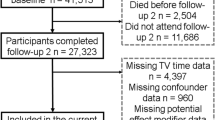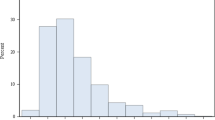Abstract
Background
Television viewing time independent of physical activity is associated with a number of chronic diseases and related risk factors; however, its relationship with chronic kidney disease is unknown.
Purpose
The purpose of this study is to examine the cross-sectional and prospective relationships of television viewing time with biomarkers of chronic kidney disease.
Methods
Participants of the Australian Diabetes, Obesity and Lifestyle Study attended the baseline (n = 10,847) and 5-year follow-up (n = 6,293) examination.
Results
Television viewing was significantly associated with increased odds of prevalent albuminuria and low estimated glomerular filtration rate. In the gender-stratified analyses this pattern was seen for men, but not for women. In the longitudinal analyses, odds of de novo albuminuria and low estimated glomerular filtration rate were increased only in unadjusted models.
Conclusions
Television viewing time may be directly related to markers of chronic kidney disease and through intertwined associated risk factors such as diabetes, hypertension, and obesity.

Similar content being viewed by others
References
Chadban S, Briganti E, Kerr P, et al. Prevalence of kidney damage in Australian adults: The AusDiab Kidney Study. Journal of the American Society of Nephrology. 2003;14:S131–S138.
Chow F, Briganti E, Kerr P, Chadban S, Zimmet P, Atkins R. Health-related quality of life in Australian adults with renal insufficiency: A population-based study. American Journal of Kidney Disease. 2003;41:596–604.
Go A, Chertow G, Fan D, McCulloch C, CY H. Chronic kidney disease and the risks of death, cardiovascular events, and hospitalization. New England Journal of Medicine. 2004;351:1296–1305.
Levey A, Coresh J, Balk E, et al. National Kidney Foundation practice guidelines for chronic kidney disease: Evaluation, classification, and stratification. Annals of Internal Medicine. 2003;139:137–147.
Gerstein H, Mann J, Yi Q, et al. Albuminuria and risk of cardiovascular events, death, and heart failure in diabetic and nondiabetic individuals. Journal of the American Medical Association. 2001;286:421–426.
Halbesma N, Kuiken D, Brantsma A, et al. Macroalbuminuria is a better risk marker than low estimated GFR to identify individuals at risk for accelerated GFR loss in population screening. Journal of the American Society of Nephrology. 2006;17:2582–2590.
Haskell W, Lee IM, Pate R, et al. Physical activity and public health: Updated recommendation for adults from the American College of Sports Medicine and the American Heart Association. Circulation. 2007;116:1081–1093.
Hallan S, de Mutsert R, Carlsen S, Dekker F, Aasarod K, Holmen J. Obesity, smoking, and physical inactivity as risk factors for CKD: Are men more vulnerable? American Journal of Kidney Disease. 2006;47:396–405.
Stengel B, Tarver-Carr M, Powe N, Eberhardt M, Brancati F. Lifestyle factors, obesity and the risk of chronic kidney disease. Epidemiology. 2003;14:479–487.
Owen N, Bauman A, Brown W. Too much sitting: A novel and important predictor of chronic disease risk? British Journal of Sports Medicine. 2009;43:81–82.
Hamilton M, Hamilton D, Zderic T. Role of low energy expenditure and sitting in obesity, metabolic syndrome, type 2 dibetes, and cardiovascular disease. Diabetes. 2007;56:2655–2667.
Hamilton M, Healy G, Dunstan D, Zderic T, Owen N. Too little exercise and too much sitting: Inactivity physiology and the need for new recommendations on sedentary behaviour. Current Cardiovascular Risk Reports. 2008;2:292–298.
Brown W, Bauman A, Owen N. Stand up, sit down, keep moving: Turning circles in physical activity research? British Journal of Sports Medicine. 2009;43:86–88.
Clark B, Sugiyama T, Healy G, Salmon J, Dunstan D, Owen N. Validity and reliability of measures of television viewing time and other non-occupational sedentary behaviour of adults: A review. Obesity Reviews. 2008;10:7–16.
Sugiyama T, Healy G, Dunstan D, Salmon J, Owen N. Is television viewing time a marker of a broader pattern of sedentary behavior? Annals of Behavioral Medicine. 2008;35:245–250.
Dunstan D, Salmon J, Owen N, et al. Physical activity and television viewing in relation to risk of undiagnosed abnormal glucose metabolism in adults. Diabetes Care. 2004;27:2603–2609.
Dunstan D, Salmon J, Owen N, et al. Associations of TV viewing and physical activity with the metabolic syndrome in Australian adults. Diabetologia. 2005;48:2254–61.
Healy G, Dunstan D, Salmon J, Shaw J, Zimmet P, Owen N. Television time and continuous metabolic risk in physically active adults. Medicine and Science in Sports and Exercise. 2008;40:639–645.
de Jong PE, Verhave JC, Pinto-Sietsma SJ, Hillege HL, PREVEND study group. Obesity and target organ damage: The kidney. International Journal of Obesity Related Metabolic Disorders. 2002;26:S21–24.
Dunstan D, Zimmet P, Welborn T, et al. The Australian diabetes, obesity and lifestyle study (AusDiab): Methods and response rates. Diabetes Research and Clinical Practice. 2002;57:119–129.
Magliano D, Barr E, Zimmet P, et al. Glucose indices, health behaviors, and incidence of diabetes in Australia: The Australian Diabetes. Obesity and Lifestyle Study. Diabetes Care. 2005;31:267–272.
World Health Organization. Definition, diagnosis and classification of diabetes mellitus and its complications. Geneva: World Health Org; 1999.
Australian Institute of Health and Welfare. The active Australia survey: A guide and manual for implementation, analysis and reporting. Canberra: AIHW; 2003.
Bauman A, Armstrong T, Davies J, et al. Trends in physical activity participation and the impact of integrated campaigns among Australian adults, 1997-99. Australian and New Zealand Journal of Public Health. 2003;27:76–79.
Department of Health and Aged Care. National physical activity guidelines for Australians. Canberra: Australian Government; 1999.
Salmon J, Owen N, Crawford D, Bauman A, Sallis J. Physical activity and sedentary behavior: A population-based study of barriers, enjoyment, and preference. Health Psychology. 2003;22:178–188.
Bertrais S, Beyerne-Ondoua JP, Czernichow S, Galan P, Hercberg S, Oppert JM. Sedentary behaviors, physical activity, and metabolic syndrome in middle-aged French subjects. Obesity Research. 2005;13:936–944.
Hu F, Leitzmann M, Stampfer M, Colditz G, Willett W, Rimm E. Physical activity and television watching in relation to risk for type 2 diabetes mellitus in men. Archives of Internal Medicine. 2001;161:1542–1548.
Dunstan D, Salmon J, Healy G, et al. Association of television viewing with fasting and 2-h postchallenge plasma glucose levels in adults without diagnosed diabetes. Diabetes Care. 2007;30:516–522.
Australian Bureau of Statistics. How Australians use their time. Canberra: Commonwealth of Australia; 1998.
Hu F, Li T, Colditz G, Willett W, Manson J. Television watching and other sedentary behaviors in relation to risk of obesity and type 2 diabetes mellitus in women. Journal of the American Medical Association. 2003;289:1785–91.
Salmon J, Bauman A, Crawford D, Timperio A, Owen N. The association between television viewing and overweight among Australian adults participating in varying levels of leisure-time physical activity. International Journal of Obesity. 2000;24:600–606.
Jakes R, Day N, Khaw K, et al. Television viewing and low participation in vigorous recreation are independently associated with obesity and markers of cardiovascular disease risk: EPIC-Norfolk population-based study. European Journal of Clinical Nutrition. 2003;57:1089–1096.
Ford E, Kohl H, Mokdad A, Ajani U. Sedentary behavior, physical activity, and the metabolic syndrome among U.S. adults. Obesity Research. 2005;13:608–614.
Healy G, Dunstan D, Salmon J, et al. Objectively measured light-intensity physical activity is independently associated with 2-h plasma glucose. Diabetes Care. 2007;30:1384–1389.
White S, Polkinghorne K, Cass A, Shaw J, Atkins R, Chadban S. Alcohol consumption and 5-year onset of chronic kidney disease: the AusDiab study. Nephrology Dialysis Transplantation. 2009;24:2464–2472.
McDonald S, Excell L, Dent H. ANZDATA Registry Report 2008. Adelaide, South Australia, 2008.
U.S. Renal Data System. USRDS 2008 Annual data report: Atlas of chronic kidney disease and end-stage renal disease in the United States. Bethesda: National Institutes of Health, National Institute of Diabetes and Digestive and Kidney Diseases; 2008.
Briganti E, Branley P, Chadban S, et al. Smoking is associated with renal impairment and proteinuria in the normal population: The AusDiab kidney study. American Journal of Kidney Diseases. 2002;40:704–712.
Iseki K, Ikemiya Y, Kinjo K, Inoue T, Iseki C, Takishita S. Body mass index and the risk of development of end-stage renal disease in a screened cohort. Kidney International. 2004;65:1870–1876.
Orth S, Stöckmann A, Conradt C, et al. Smoking as a risk factor for end-stage renal failure in men with primary renal disease. Kidney International. 1998;54:926–931.
Shankar A, Leng C, Chia K, et al. Association between body mass index and chronic kidney disease in men and women: population-based study of Malay adults in Singapore. Nephrology Dialysis Transplantation. 2008;23:1910–1918.
Tozawa M, Iseki K, Iseki C, Oshiro S, Ikemiya Y, Takishita S. Influence of smoking and obesity on the development of proteinuria. Kidney International. 2002;62:956–962.
Pischon T, Boeing H, Hoffmann K, et al. General and Abdominal Adiposity and Risk of Death in Europe. New England Journal of Medicine. 2008;359:2105–2120.
Xing D, Nozell S, Chen Y, Hage F, Oparil S. Estrogen and Mechanisms of Vascular Protection. Arteriosclerosis, Thrombosis and Vascular Biology. 2009;29:289–295.
Acknowledgements
Lynch is supported by a NHMRC public health training fellowship (#586727). Healy is supported by NHMRC (#569861)/National Heart Foundation of Australia (PH08B3905) postdoctoral fellowship. Owen is supported by a Queensland health core research infrastructure grant and by NHMRC Program Grant funding (#301200). Dunstan is supported by a Victorian Health Promotion Foundation public health research fellowship.
The AusDiab study, co-coordinated by the Baker IDI Heart and Diabetes Institute, gratefully acknowledges the generous support given by NHMRC (#233200); the Australian Government Department of Health and Ageing; Abbott Australasia; Alphapharm; AstraZeneca; Aventis Pharma; Bio-Rad Laboratories; Bristol-Myers Squibb; the city health centre; diabetes service, Canberra; Department of Health and Community Services, Northern Territory; Department of Health and Human Services, Tasmania; Department of Health, New South Wales; Department of Health, Western Australia; Department of Health, South Australia; Department of Human Services, Victoria, Diabetes Australia; Diabetes Australia Northern Territory; Eli Lilly Australia; estate of the late Edward Wilson; GlaxoSmithKline; Highpoint Shopping Centre; Jack Brockhoff Foundation; Janssen–Cilag; Kidney Health Australia; Marian and EH Flack Trust; Menzies Research Institute; Merck Sharp and Dohme; Multiplex; Novartis Pharmaceuticals; Novo Nordisk Pharmaceuticals; Pfizer; Pratt Foundation; Queensland Health; Roche Diagnostics Australia; Royal Prince Alfred Hospital, Sydney; and Sanofi-Synthelabo.
Also, for their invaluable contribution to the setup and field activities of AusDiab, we are enormously grateful to A Allman, B Atkins, S Bennett, A Bonney, S Chadban, M de Courten, M Dalton, T Dwyer, H Jahangir, D Jolley, M Lee, D McCarty, A Meehan, N Meinig, S Murray, K O’Dea, K Polkinghorne, P Phillips, C Reid, A Stewart, R Tapp, H Taylor, T Whalen, F Wilson, and P Zimmet.
Conflict of Interest Statement
The authors have no conflicts of interest to disclose.
Author information
Authors and Affiliations
Corresponding author
About this article
Cite this article
Lynch, B.M., White, S.L., Owen, N. et al. Television Viewing Time and Risk of Chronic Kidney Disease in Adults: The AusDiab Study. ann. behav. med. 40, 265–274 (2010). https://doi.org/10.1007/s12160-010-9209-1
Published:
Issue Date:
DOI: https://doi.org/10.1007/s12160-010-9209-1




